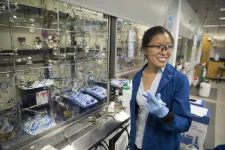Laser-driven experiments provide insights into the formation of the universe
Laser-driven experiments conducted on the OMEGA laser at the University of Rochester capture for the first time in a laboratory setting the time history of the growth of magnetic fields by the "turbulent dynamo."
2021-03-11
(Press-News.org) The universe is filled with magnetic fields. Understanding how magnetic fields are generated and amplified in plasmas is essential to studying how large structures in the universe were formed and how energy is divided throughout the cosmos.
An international collaboration, co-led by researchers at the University of Rochester, the University of Oxford, and the University of Chicago, conducted experiments that captured for the first time in a laboratory setting the time history of the growth of magnetic fields by the turbulent dynamo, a physical mechanism thought to be responsible for generating and sustaining astrophysical magnetic fields. The experiments accessed conditions relevant to most plasmas in the universe and quantified the rate at which the turbulent dynamo amplifies magnetic fields, a property previously only derived from theoretical predictions and numerical simulations. The rapid amplification they found exceeds theoretical expectations and could help explain the origin of the present-day large-scale fields that are observed in galaxy clusters. Their results were published on March 8 in the Proceedings of the National Academy of Sciences.
The researchers--part of the Turbulent Dynamo (TDYNO) team--conducted their experimental research at the Omega Laser Facility at the University of Rochester's Laboratory for Laser Energetics (LLE), where they had previously demonstrated experimentally the existence of the turbulent dynamo mechanism. That breakthrough earned the team the 2019 John Dawson Award for Excellence in Plasma Physics Research from the American Physical Society.
In their most recent experiments at the Omega Laser Facilty, the researchers used laser beams whose total power is equivalent to that of 10,000 nuclear reactors. They were able to achieve conditions relevant to the hot, diffuse plasma of the intracluster medium in which the turbulent dynamo mechanism is thought to operate. The team then measured as a function of time the magnetic field amplification produced by this mechanism.
"Understanding how and at what rates magnetic fields are amplified at macroscopic scales in astrophysical turbulence is key for explaining the magnetic fields seen in galaxy clusters, the largest structures in the Universe," says Archie Bott, a postdoctoral research associate in the Department of Astrophysical Sciences at Princeton and lead author of the study. "While numerical models and theory predict fast turbulent dynamo amplification at very small scales compared to turbulent motions, it had remained uncertain as to whether the mechanism operates rapidly enough to account for dynamically significantly fields on the largest scales."
At the core of the astrophysical dynamo mechanism is turbulence. Primordial magnetic fields are generated with strengths that are considerably smaller than those seen today in galaxy clusters. Stochastic plasma motions, however, can pick up these weak "seed" fields and amplify their strengths to significantly larger values via stretching, twisting and folding of the field. The rate at which this amplification happens, the "growth rate," differs for the different spatial scales of the turbulent plasma motions: theory and simulations predict that the growth rate is large at the smallest length scales but far smaller at length scales comparable to those of the largest turbulent motions. The TDYNO experiments demonstrated that this may not be the case: turbulent dynamo--when operating in a realistic plasma--can generate large-scale magnetic fields much more rapidly than currently expected by theorists.
"Our theoretical understanding of the workings of turbulent dynamo has grown continuously for over half a century," says Gianluca Gregori, a professor of physics in the Department of Physics at the University of Oxford and the experimental lead of the project. "Our recent TDYNO laser-driven experiments were able to address for the first time how turbulent dynamo evolves in time, enabling us to experimentally measure its actual growth rate."
These experiments are part of a concerted effort by the TDYNO team to answer key questions that are debated in the turbulent dynamo literature, establishing laboratory experiments as a component in the study of turbulent magnetized plasmas. The collaboration has built an innovative experimental platform that, coupled with the power of the OMEGA laser, enables the team to probe the different plasma regimes relevant to various astrophysical systems. The experiments are designed using numerical simulations performed with the FLASH code, a publicly available simulation code that can accurately model laser-driven experiments of laboratory plasmas. FLASH is developed by the Flash Center for Computational Science, which recently moved from the University of Chicago to the University of Rochester.
"The ability to do high-fidelity, predictive modeling with FLASH, and the state-of-the art diagnostic capabilities of the Omega Laser Facility at the LLE, have put our team in a unique position to decisively advance our understanding of how cosmic magnetic fields come to be," says Petros Tzeferacos, an associate professor in the Department of Physics and Astronomy at the University of Rochester and a senior scientist at the LLE--the simulation lead of the project. Tzeferacos also serves as director of the Flash Center at Rochester.
"This work blazes a path to laboratory investigations of a variety of astrophysical processes mediated by magnetized turbulence," adds Don Lamb, the Robert A. Millikan Distinguished Service Professor Emeritus in Astronomy and Astrophysics at the University of Chicago and principal investigator of the TDYNO National Laser User's Facility (NLUF) project. "It's truly exciting to see the scientific results that the ingenuity of this team is making possible."
INFORMATION:
The project was funded by the US Department of Energy, the National Science Foundation, the European Research Council, the Engineering and Physical Sciences Research Council, the National Laser Users' Facility of DOE's National Nuclear Security Administration, and the ASCR Leadership Computing Challenge of the DOE Office of Science.
ELSE PRESS RELEASES FROM THIS DATE:
2021-03-11
Optical-resolution photoacoustic microscopy (OR-PAM), a new hybrid imaging technique, allows us to listen to the sound of light and see the color of biological tissue itself. It can be used for live, multicontrast functional imaging, but the limited wavelength choice of most commercial lasers and the limitations of the existing scanning methods have meant that OR-PAM can obtain only one or two different types of contrast in a single scan. These limitations have made multicontrast functional imaging time-consuming, and it's been difficult to capture the ...
2021-03-11
Ann Arbor, March 11, 2020 - Black and Hispanic people experience a higher risk for COVID-19 and severe illness, influenced by factors such as discrimination, housing, and healthcare access and utilization. Now, a END ...
2021-03-11
CHAMPAIGN, Ill. -- The chronic stress of living in neighborhoods with high rates of violence and poverty alters gene activity in immune cells, according to a new study of low-income single Black mothers on the South Side of Chicago.
The changes in stress-related gene expression reflect the body's "hunker down" response to long-term threat, a physiological strategy for lying low and considering new actions rather than launching an immediate "fight-or-flight" response. This has implications for health outcomes in communities of color and other marginalized populations, said researchers at the University of Illinois Urbana-Champaign and collaborators at the University of Kentucky and UCLA. The researchers published the study in the journal Psychoneuroendocrinology.
"The ...
2021-03-11
GAINESVILLE, Fla. --- The showy colors of some butterflies could advertise their speed and nimbleness, much like a coat of bright yellow paint on a sports car. A new study shows birds can learn to recognize these visual cues, avoiding not only butterflies they've failed to nab in the past but similar-looking species as well.
The research provides some of the strongest evidence to date for the idea of evasive mimicry, a strategy in which animals protect themselves from predators by matching the colors or patterns of agile relatives. First proposed more than 60 years ago, the hypothesis has been a challenge to test.
But in an experimental setting, ...
2021-03-11
SAN ANTONIO -- Surgically opening the windpipe, or trachea, within the first seven days of the start of mechanical ventilation decreases the time patients spend on ventilators, shortens their ICU stay and lowers their risk of ventilator-associated pneumonia, according to a systematic review published Thursday (March 11) in JAMA Otolaryngology-Head & Neck Surgery.
"We analyzed the existing medical literature to unravel a question that is very pertinent to adult critical care," said senior author Alvaro Moreira, MD, MSc, of The University of Texas Health Science Center at San Antonio (UT Health San ...
2021-03-11
The global battle against antibiotic resistance can only succeed if local contexts are taken into account. "A tailored approach is needed in each country," says Heiman Wertheim of Radboud university medical center. "There is no "one-size-fits-all' solution." This was the main finding of a study on antibiotic resistance in African and Asian countries funded by the British Wellcome Trust. Wertheim is the lead investigator of a large group of international researchers who recently published an article on this study in The Lancet Global Health.
Antibiotics are powerful treatments for bacterial infections. They are indispensable for controlling infections such as pneumonia, meningitis, or blood poisoning (sepsis) caused by bacteria. But they are ineffective for treating ...
2021-03-11
Sugar has been called "evil," "toxic," and "poison." But the body needs sugars, too. Sugar molecules help cells recognize and fight viruses and bacteria, shuttle proteins from cell to cell, and make sure those proteins function. Too much or too little can contribute to a range of maladies, including neurodegenerative diseases like Alzheimer's, inflammation, diabetes, and even cancer.
About 85 percent of proteins, including those associated with Alzheimer's and Parkinson's, are beyond the reach of current drugs. One critical and abundant sugar (O-GlcNAc, pronounced o-glick-nack) is found on over 5,000 proteins, often those considered "undruggable." But now, researchers at Harvard University ...
2021-03-11
Boston, MA - Vaccinating adults age 26 and older against the human papillomavirus (HPV)--the virus that causes more than 90% of cervical cancers as well as several other cancers--may not be cost-effective, according to a new study led by researchers at the Harvard T.H. School of Public Health.
"Our study found that the added health benefit of increasing the vaccination age limit beyond 26 years is minimal, and that the cost-effectiveness is much lower than in pre-adolescents, the target age group for the HPV vaccine," said Jane Kim, K.T. Li Professor of Health Economics and lead author of the study.
The study will be published March 11, 2021, in PLOS Medicine.
HPV vaccines have been shown to be highly effective in preventing ...
2021-03-11
Eating is a dangerous business. Naturally occurring toxins in food and potentially harmful foodborne microbes can do a number on our intestines, leading to repeated minor injuries. In healthy people, such damage typically heals in a day or two. But in people with Crohn's disease, the wounds fester, causing abdominal pain, bleeding, diarrhea and other unpleasant symptoms.
Researchers at Washington University School of Medicine in St. Louis and the Cleveland Clinic have discovered that a fungus found in foods such as cheese and processed meats can infect sites of intestinal damage in mice and people with Crohn's and prevent healing. Moreover, treating infected mice with antifungal medication eliminates the fungus and allows the wounds ...
2021-03-11
Insights into how bacterial proteins work as a network to take control of our cells could help predict infection outcomes and develop new treatments.
Much like a hacker seizes control of a company's software to cause chaos, disease-causing bacteria, such as E. coli and Salmonella, use miniature molecular syringes to inject their own chaos-inducing agents (called effectors) into the cells that keep our guts healthy.
These effectors take control of our cells, overwhelming their defences and blocking key immune responses, allowing the infection to take hold.
Previously, studies have investigated single effectors. Now a team led by scientists at Imperial College London and The Institute of Cancer ...
LAST 30 PRESS RELEASES:
[Press-News.org] Laser-driven experiments provide insights into the formation of the universe
Laser-driven experiments conducted on the OMEGA laser at the University of Rochester capture for the first time in a laboratory setting the time history of the growth of magnetic fields by the "turbulent dynamo."


